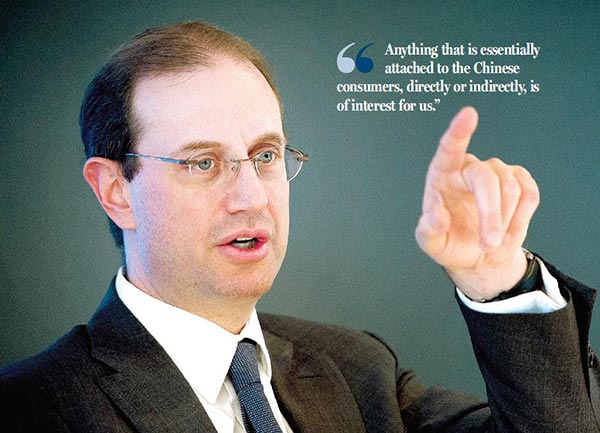Inside the mind of a pension fund manager
By Li Xiang (China Daily) Updated: 2016-04-15 08:21
 |
|
Mark Wiseman, chief executive officer of the Canada Pension Plan Investment Board.BLOOMBERG VIA GETTY IMAGES |
Mark Wiseman wants to make China a core part of CPPIB's investment strategy
When it comes to growing its investment in China, what Mark Wiseman, president and chief executive of the Canada Pension Plan Investment Board, has in mind is China's share of the global gross domestic product.
Wiseman, who manages one of the world's largest pension funds with total assets worth $215.7 billion at of the end of 2015, intends to match the fund's presence in China with the share of the Chinese economy in the world, which will represent somewhat between 25 to 30 percent of the global GDP by 2040.
The CPPIB has deployed about $10 billion investment in China so far, which accounts for about 4.3 percent of the fund's total assets globally, he said.
"If we want to be GDP weighted, we have a massive way to go in terms of our growth," Wiseman told China Daily in a recent interview.
He said he intends to grow the fund's investment in China significantly in the coming years by tapping into the rise of consumer demand and building up cross-asset portfolios that cover sectors including real estate, logistics, infrastructure and private and public equities market.
The CPPIB has been investing in China since 2008. Some of its high-profile deals include the $314.5 million investment in China's e-commerce giant Alibaba Group Holding Ltd since 2011 as well as the joint venture it formed last year with China's largest residential developer Vanke Co Ltd to invest a total of $250 million in the Chinese real estate market.
One of its recent moves in China is the $500 million cornerstone investment in Postal Savings Bank of China Co, which is planning an initial public offering.
The CPPIB also manages an investment quota of $1.2 billion in the Chinese equities market under the Qualified Foreign Institutional Investor program. It has also gained the license to invest in the Chinese interbank bond market.
Wiseman stressed that the CPPIB takes a long-term view on China. Instead of looking at the short-term movements in the equities and foreign exchange markets, the fund focuses on the larger trends, including the shift of the Chinese economy away from the inefficient industries to the more productive private and service sectors, he said.
"That is why we are holding a positive view on China and continue to make China a very core part of our investment strategy," he said.
The following are edited excerpts from the interview:
What is your assessment of the Chinese economy and how will the economic transformation in the country affect your investment strategy?
I think the 6.5 to 7 percent growth figure is achievable. We take a long-term view on the development of the economy. We are not hot money. We don't focus on what happens to the Shanghai Stock Exchange on Wednesday or what currency markets do on Thursday.
We are looking at the big trends, including what is happening to the demographics and to the rise of consumer demand and how is the economy shifting away from inefficient State-owned industries to having a larger proportion of economic growth coming from more highly productive service sector. Today we have $10 billion invested in China. We expect that number to continue to increase significantly.
What do you mean by 'increase significantly'?
Our investment in China represents about 4.3 percent of the fund. By 2040, the expectation is that China will represent somewhere between 25 to 30 percent of the global GDP. Even if we want to be GDP weighted, we have a massive way to go in terms of our growth. The challenge for us is how we take this 4.3 percent and get something closer to 25 percent. The job of getting more capital into the market is one of the most important strategic issues that we have.
What sectors in China do you want to increase the fund's exposure to and what sectors do you plan to exit?
We have no plan of exiting from anything. Anything that is essentially attached to the Chinese consumers, directly or indirectly, is of interest for us. We look at opportunities in sectors related to the growing middle class and the growing consumer demand driven by the private sector as opposed to the State-owned sector.
How do you hedge or manage risks of your investment in China?
We don't hedge risks. We want to take that risks. We manage risks by being very careful about who we choose as partners. It also involves being incredibly diligent when we decide to make any individual investment, whether it is a piece of real estate or in a PE company.
People make mistakes in thinking that investing is about hedging risks. That would be a free lunch.
In the investing business, there is no free lunch. We know that we have to take risks. We want to make sure that we understand the risks and we are able to get compensated appropriately.
How do you see the volatilities of the Chinese stock market and the way the government stepped in to stem the market rout?
I think the best solution to have a disciplined market is to have disciplined investors. So the more long-term institutional investors with deep experience that are able to participate freely in the market, the less volatility and the greater degree of rationality that will be in the market.
While some investors get scared by the volatility, we see opportunity. It is because as investors are coming in and out, selling and buying, we keep our eyes focused on the horizon, which will allow us to find deep value. We think it is a very attractive investment environment right now for long-term investors.
Is there any Canadian experience on the pension fund reform that you think China can learn from?
We are very lucky in Canada that in 1997 there was a fundamental reform of the national pension scheme, which was led by then finance minister Paul Martin who tried to put in place a system that will be sustainable for generations. China has a population that is living longer. But you also have a population in terms of structure that is going to be disproportionally old as a result of the one-child policy.
I think it is better to start earlier to look at the structure of the pension system and understand that you want to be in the position to support the retirees for a long period of time.
The good news is that China has time given its economic growth and the profile of the population. But it doesn't have much time. So the sooner the government is able to move through those reforms, the better it is.
What is the difference between managing a pension fund and managing a regular investment firm?
In many respects, we operate like an investment company because we have one client that is the national pension system. One big difference for us is we always need to have an understanding of our liabilities. There are 19 million people in Canada who rely on our investment.
We know very clearly our job is to make risk-adjusted return in order to pay the pensions of the 19 million people. I think in many respects, we have an easier time managing our portfolio than either a private asset management firm that has many different clients with many different needs or a sovereign wealth fund where it is often not clear who the client is.
What is your management philosophy?
There is a Chinese proverb that goes: Never trip at the same stone twice. In the investment business, making mistakes is OK. What you don't want to do is make the same mistake twice. I think my philosophy is that taking risk is part of the job and part of constructing a good portfolio. What defines what we do at the CPPIB is constant learning and refinement of the processes and our knowledge.
What are your hobbies?
I am a Canadian so I love anything that has to do with ice hockey. I have played ice hockey for 40 years since I was five years old. I very much look forward to the 2022 Winter Olympics in Beijing.
CV
Age: 45
Nationality: Canadian
Education: Bachelor's degree from Queen's University and a law degree and MBA from the University of Toronto. Obtaining a Master's degree in law at Yale University.
Career:
2012 onwards: President and CEO of the CPPIB
2005-12: Executive vice-president and senior vice-president of the CPPIB
2002-05: Vice-president of private equity fund and co-investment program at Ontario Teachers' Pension Plan
2000-01: Vice-president at Harrowston Inc.
1998-2000: Corporate lawyer at Sullivan & Cromwell
- China's export hub opens regular cargo train to Europe
- Djibouti port signs partnership agreement with China's Qingdao port
- More fluctuation in the stock market expected
- The logistics people who make rural e-commerce possible
- China's least affordable housing market: Shenzhen
- Chinese economy sees rosy start, pressure remains
- Mutual trust to guarantee both sides benefit from China's FDI in US
- China's Internet regulation not trade barrier















